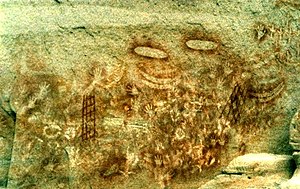
The Dreaming, also referred to as Dreamtime, is a term devised by early anthropologists to refer to a religio-cultural worldview attributed to Australian Aboriginal mythology. It was originally used by Francis Gillen, quickly adopted by his colleague Sir Baldwin Spencer and thereafter popularised by A. P. Elkin, who, however, later revised his views.
The Dreaming is used to represent Aboriginal concepts of "Everywhen", during which the land was inhabited by ancestral figures, often of heroic proportions or with supernatural abilities. These figures were often distinct from gods, as they did not control the material world and were not worshipped but only revered.[citation needed] The concept of the Dreamtime has subsequently become widely adopted beyond its original Australian context and is now part of global popular culture.
The term is based on a rendition of the Arandic word alcheringa, used by the Aranda (Arunta, Arrernte) people of Central Australia, although it has been argued that it is based on a misunderstanding or mistranslation. Some scholars suggest that the word's meaning is closer to "eternal, uncreated".[2] Anthropologist William Stanner said that the concept was best understood by non-Aboriginal people as "a complex of meanings".[3] Jukurrpa is a widespread term used by Warlpiri people and other peoples of the Western Desert cultural bloc.[3][4][5]
By the 1990s, Dreaming had acquired its own currency in popular culture, based on idealised or fictionalised conceptions of Australian mythology.[citation needed] Since the 1970s, Dreaming has also returned from academic usage via popular culture and tourism and is now ubiquitous in the English vocabulary of Aboriginal Australians in a kind of "self-fulfilling academic prophecy".[2][a]
- ^ Walsh 1979, pp. 33–41.
- ^ a b Swain 1993, p. 21.
- ^ a b Nicholls 2014a.
- ^ Central Art: Jukurrpa.
- ^ NMoA: Jukurrpa.
Cite error: There are <ref group=lower-alpha> tags or {{efn}} templates on this page, but the references will not show without a {{reflist|group=lower-alpha}} template or {{notelist}} template (see the help page).